Rear-facing child restraint installation using LATCH
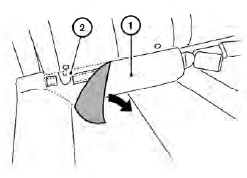
Refer to all Warnings and Cautions in the “Child Safety” and “Child Restraint” sections before installing a child restraint.
Follow these steps to install a rear-facing child restraint using the LATCH system:
1. If the rear seat cushion has a flap 1 , pull the flap down to allow access to the anchors 2 .
2. Position the child restraint on the seat. Always follow the child restraint manufacturer’s instructions.
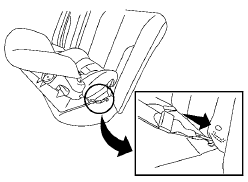
Rear-facing web-mounted – step 3
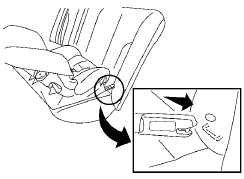
Rear-facing rigid-mounted – step 3
3. Secure the child restraint anchor attachments to the LATCH lower anchors. Check to make sure the LATCH attachment is properly attached to the lower anchors.
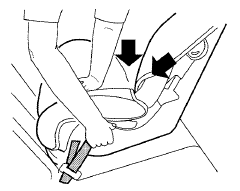
Rear-facing – step 4
4. For child restraints that are equipped with webbing-mounted attachments, remove any additional slack from the anchor attachments. Press downward and rearward firmly in the center of the child restraint with your hand to compress the vehicle seat cushion and seatback while tightening the webbing of the anchor attachments.
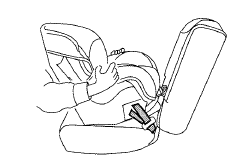
Rear-facing – step 5
5. After attaching the child restraint, test it before you place the child in it. Push it from side to side while holding the child restraint near the LATCH attachment path. The child restraint should not move more than 1 inch (25 mm), from side to side. Try to tug it forward and check to see if the LATCH attachment holds the restraint in place. If the restraint is not secure, tighten the LATCH attachment as necessary, or put the restraint in another seat and test it again. You may need to try a different child restraint or try installing by using the vehicle seat belt (if applicable). Not all child restraints fit in all types of vehicles.
6. Check to make sure the child restraint is properly secured prior to each use. If the child restraint is loose, repeat steps 2 through 5.
See also:
Rear Control Cancel Switch (if so equipped)
The rear control cancel switch operates when the
ignition switch is placed in the ACC or ON position.
The rear control cancel switch is located on the
left side of the instrument panel.
Pushin ...
“Phonebook” (phones without automatic phonebook
download function)
NOTE.
The “Transfer Entry” command is not available
when the vehicle is moving.
For phones that do not support automatic download
of the phonebook (PBAP Bluetooth profile),
the “Phoneb ...
Engine compartment check locations
Engine compartment check locations
1. Power steering fluid reservoir.
2. Engine oil filler cap.
3. Brake fluid reservoir.
4. Air cleaner.
5. Fuse block.
6. Battery.
7. Fuse/fusible link box.
...
